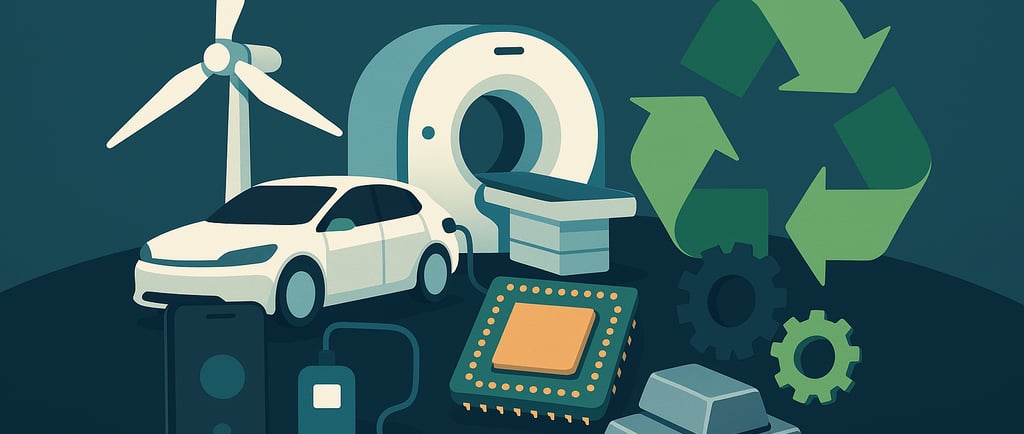Metals of the Future: Rare Earth Elements and Their Role in High-Tech Recycling
Discover how rare earth elements power modern tech and how high-tech recycling can ensure a sustainable supply. Explore challenges, geopolitical tensions, and innovative solutions shaping the future.
SUSTAINABLE METALS & RECYCLING INNOVATIONS


Introduction
Rare earth metals — the unsung heroes behind modern technology — are rapidly becoming the cornerstone of a sustainable, innovation-driven future. These critical materials power everything from smartphones and electric vehicles (EVs) to wind turbines, MRI scanners, and advanced defense technologies. Their unparalleled electrochemical, magnetic, and optical properties make them not only valuable but irreplaceable for many high-performance systems.
As the world accelerates toward a low-carbon economy, the global appetite for rare earth elements (REEs) is rapidly intensifying. This growth is amplified by three simultaneous mega-trends: the green energy revolution, the widespread digitization of industry (Industry 4.0), and escalating geopolitical competition over critical minerals.
In this article, we explore the strategic importance of rare earth metals, analyze the supply-and-demand pressures shaping global markets, and dive into how advanced, high-tech recycling could hold the key to long-term rare earth sustainability.
Whether you're a sustainability advocate, policy strategist, business leader, or tech futurist, this guide will provide you with a comprehensive look at why rare earth elements matter — and how we can recycle them to power the future responsibly.
What Are Rare Earth Elements?
Definition and Classification
Rare earth elements (REEs) are a collection of 17 metallic elements on the periodic table, comprising the 15 lanthanides, plus scandium and yttrium. These materials are known for their unique chemical characteristics, including high conductivity, catalytic behavior, and exceptional fluorescence and magnetism.
Misconceptions About Rarity
Contrary to their name, REEs are not especially rare in terms of abundance. Cerium, for example, is more plentiful than copper in the Earth's crust. However, economically concentrated rare earth deposits are less common, and mining them often entails significant environmental and economic costs.
Classification of Rare Earth Elements
Light Rare Earth Elements (LREEs): Lanthanum, cerium, praseodymium, neodymium, etc.
Heavy Rare Earth Elements (HREEs): Europium, terbium, dysprosium, holmium, etc.
Each of these metals plays a distinct role in various high-tech applications, and they are often used in small but critical quantities.
Use Cases in High-Tech Industries
1. Electric Vehicles (EVs)
Permanent magnet motors using neodymium and dysprosium
Improved range, torque, and energy efficiency
2. Renewable Energy
High-efficiency generators and inverters in wind and solar power systems
3. Consumer Electronics
Smartphones, tablets, laptops, and wearables with REE-based components
4. Defense Systems
Smart missiles, satellites, and advanced visual displays
5. Medical Imaging
MRI machines and diagnostic systems using REEs
The challenge, however, lies not in where we find REEs, but in how we obtain, refine, and reuse them — all while safeguarding human and environmental health.
Geographic Concentration of Supply
China's Dominance
More than 85% of rare earth refining occurs in China, which also dominates global mining. According to the United States Geological Survey (USGS), China produced approximately 70% of the world’s rare earth materials in 2023, creating vulnerabilities for global supply chains.
Global Responses
United States, Canada, and Australia: Increasing domestic extraction and investing in recycling technologies.
EU Critical Raw Materials Act: Encouraging supply chain diversification.
Inflation Reduction Act (U.S.): Providing subsidies for domestic rare earth initiatives.
Rare Earth Metals Behind the Tech Renaissance
1. Electronics: The Invisible Backbone of Smart Devices
Neodymium-iron-boron (NdFeB) magnets are used extensively in speakers, headphones, smartphone vibration units, and hard disk drives.
Europium and terbium are essential for producing vibrant, energy-efficient LED and fluorescent displays.
Fast Fact: A smartphone may contain over a dozen different rare earth elements.
2. Electric Vehicles (EVs): The Catalyst for Rare Earth Growth
High-power density, lightweight permanent magnets
Tesla's Approach: While Tesla has experimented with reducing REE use, their unmatched magnetic strength remains vital for performance.
Forecast: EV demand for rare earths is projected to multiply 5 to 10 times by 2035.
3. Renewable Energy: Scaling Clean Power
Wind turbines, particularly offshore systems, rely heavily on NdFeB magnets.
Achieving global net-zero emissions by 2050 will quadruple renewable energy capacity, dramatically increasing rare earth consumption.
The Geopolitics and Environmental Costs of Rare Earth Mining
1. Geopolitical Flashpoints
China’s Dominance: The country’s influence over pricing and availability
Trade Wars & Sanctions: Rare earths used as bargaining chips
Global Rebalancing: Nations investing in diversification to reduce reliance on China
2. Environmental and Social Costs
Radioactive Byproducts: Mining produces substantial radioactive waste.
Deforestation and Habitat Loss: Threats to biodiversity in ecologically sensitive regions.
Labor Exploitation: Child labor and hazardous conditions in artisanal mining.
High-Tech Recycling: Solving the Rare Earth Dilemma
Benefits of Recycling
Reduced Environmental Impact: Recycling requires significantly less energy and produces fewer emissions than mining.
Supply Chain Stability: Mitigates reliance on geopolitical hotspots.
Economic Opportunities: Enables companies to lower costs through secondary resource recovery.
Innovative Solutions
1. Urban Mining
Extracting rare earth elements from e-waste, which can contain up to 50x higher concentrations than primary deposits.
2. Bioleaching
Using bacteria to recover REEs from mine tailings, reducing energy consumption.
3. Magnet-to-Magnet Recycling
Honda and Umicore’s closed-loop system for EV motor magnets lowers costs by 30%.
Breakthrough Technologies Enabling Circularity
1. AI-Driven Material Recovery
Sortera Technologies: Uses machine learning to identify and separate REE-rich components with 98% accuracy.
2. Modular Refining
Phoenix Tailings: Portable plasma reactors for on-site REE refining.
3. Next-Gen Magnet Design
Gradient Alloys: Developing magnets with reduced dysprosium content for easier recycling.
Conclusion: A Sustainable Rare Earth Future
The path to rare earth sustainability hinges on three pillars:
Geopolitical Diversification
Environmentally Sound Recycling
Cutting-Edge Innovation
As demand surges for EVs, wind turbines, and AI hardware, circular strategies will determine which nations and corporations lead the tech frontier.
Your Move
For Policymakers: Fast-track permits for recycling facilities and mandate REE recovery quotas.
For Businesses: Audit supply chains for secondary REE sources and partner with urban mining startups.
For Consumers: Recycle electronics through certified programs like ERA or E-Stewards.
The rare earth crisis isn’t a scarcity problem — it’s a reinvention opportunity.
